您好,登錄后才能下訂單哦!
您好,登錄后才能下訂單哦!
這篇文章主要為大家展示了“SpringBoot如何搭建多數據源”,內容簡而易懂,條理清晰,希望能夠幫助大家解決疑惑,下面讓小編帶領大家一起研究并學習一下“SpringBoot如何搭建多數據源”這篇文章吧。
首先我們建立兩個數據庫(可以不在同一臺電腦上):
multiple_order:
DROP DATABASE IF EXISTS `multiple_order`; CREATE DATABASE `multiple_order`; USE `multiple_order`; CREATE TABLE `order` ( `order_id` BIGINT UNSIGNED PRIMARY KEY AUTO_INCREMENT COMMENT '訂單id', `user_id` BIGINT UNSIGNED NOT NULL COMMENT '用戶id', `cost` DECIMAL(13, 2) COMMENT '訂單費用' ) COMMENT '訂單表';
multiple_user:
DROP DATABASE IF EXISTS `multiple_user`; CREATE DATABASE `multiple_user`; USE `multiple_user`; CREATE TABLE `user` ( `user_id` BIGINT UNSIGNED PRIMARY KEY AUTO_INCREMENT COMMENT '用戶id', `username` VARCHAR(50) NOT NULL COMMENT '用戶名', `age` TINYINT UNSIGNED COMMENT '年齡' ) COMMENT '用戶表';
然后創建一個maven項目,其中 pom.xml 文件:
<?xml version="1.0" encoding="UTF-8"?> <project xmlns="http://maven.apache.org/POM/4.0.0" xmlns:xsi="http://www.w3.org/2001/XMLSchema-instance" xsi:schemaLocation="http://maven.apache.org/POM/4.0.0 http://maven.apache.org/xsd/maven-4.0.0.xsd"> <modelVersion>4.0.0</modelVersion> <!-- SpringBoot的夫項目 --> <parent> <groupId>org.springframework.boot</groupId> <artifactId>spring-boot-starter-parent</artifactId> <version>2.3.9.RELEASE</version> </parent> <groupId>love.xiaohh.datasource</groupId> <artifactId>multiple-datasources</artifactId> <version>1.0-SNAPSHOT</version> <properties> <maven.compiler.source>8</maven.compiler.source> <maven.compiler.target>8</maven.compiler.target> </properties> <dependencies> <!-- SpringMVC 相關的依賴 --> <dependency> <groupId>org.springframework.boot</groupId> <artifactId>spring-boot-starter-web</artifactId> </dependency> <!-- Spring 健康檢測模塊 --> <dependency> <groupId>org.springframework.boot</groupId> <artifactId>spring-boot-starter-actuator</artifactId> </dependency> <!-- mybatis 相關依賴 --> <dependency> <groupId>org.mybatis.spring.boot</groupId> <artifactId>mybatis-spring-boot-starter</artifactId> <version>2.2.0</version> </dependency> <!-- MySQL 驅動 --> <dependency> <groupId>mysql</groupId> <artifactId>mysql-connector-java</artifactId> </dependency> <!-- json 工具類 --> <dependency> <groupId>com.alibaba</groupId> <artifactId>fastjson</artifactId> <version>1.2.78</version> </dependency> </dependencies> <build> <plugins> <!-- 制作一個可運行的 jar 包需要的插件 --> <plugin> <groupId>org.springframework.boot</groupId> <artifactId>spring-boot-maven-plugin</artifactId> </plugin> </plugins> </build> </project>
在 application.yml 中需要配置兩個數據源:
spring: datasource: # 用戶模塊數據庫配置 user: driver-class-name: com.mysql.cj.jdbc.Driver jdbc-url: jdbc:mysql://127.0.0.1:3306/multiple_user?useUnicode=true&characterEncoding=utf8&zeroDateTimeBehavior=convertToNull&useSSL=true&serverTimezone=GMT%2B8 username: root password: xiaohh # 訂單模塊數據庫配置 order: driver-class-name: com.mysql.cj.jdbc.Driver jdbc-url: jdbc:mysql://127.0.0.1:3306/multiple_order?useUnicode=true&characterEncoding=utf8&zeroDateTimeBehavior=convertToNull&useSSL=true&serverTimezone=GMT%2B8 username: root password: xiaohh mybatis: # Mapper 的目錄 mapper-locations: classpath:mapper/**/*Mapper.xml
然后我們定義一個配置類 DataSourseConfig 用于配置多數據源,首先是申明數據源,按照 application.yml 當中的配置定義兩個數據源,注意當中的DataSource 是 javax.sql.DataSource:
/**
* 配置用戶的數據源
*
* @return 用戶的數據源對象
*/
@Primary // 需要一個默認配置的數據源
@Bean("user")
@ConfigurationProperties(prefix = "spring.datasource.user") // 在yml中配置數據源的前綴
public DataSource user() {
return DataSourceBuilder.create().build();
}
/**
* 配置訂單的數據源
*
* @return 訂單的數據源對象
*/
@Bean("order")
@ConfigurationProperties(prefix = "spring.datasource.order") // 在yml中配置數據源的前綴
public DataSource order() {
return DataSourceBuilder.create().build();
}然后創建 SqlSessionFactory :
/**
* 注冊用戶的 SqlSession 工廠
*
* @param user 數據源
* @return SqlSession 工廠
* @throws Exception 可能會拋出異常
*/
@Primary // 配置一個這個類型默認的 bean
@Bean("userSqlSessionFactory")
public SqlSessionFactory userSqlSessionFactory(@Qualifier("user") DataSource user) throws Exception {
// 創建bean
SqlSessionFactoryBean factory = new SqlSessionFactoryBean();
// 設置數據源
factory.setDataSource(user);
// 設置 mapper 文件的掃描
factory.setMapperLocations(new PathMatchingResourcePatternResolver().getResources("classpath:mapper/user/*.xml"));
return factory.getObject();
}
/**
* 注冊訂單的 SqlSession 工廠
*
* @param order 數據源
* @return SqlSession 工廠
* @throws Exception 可能會拋出異常
*/
@Bean("orderSqlSessionFactory")
public SqlSessionFactory orderSqlSessionFactory(@Qualifier("order") DataSource order) throws Exception {
// 創建bean
SqlSessionFactoryBean factory = new SqlSessionFactoryBean();
// 設置數據源
factory.setDataSource(order);
// 設置 mapper 文件的掃描
factory.setMapperLocations(new PathMatchingResourcePatternResolver().getResources("classpath:mapper/order/*.xml"));
return factory.getObject();
}最后聲明兩個 SqlSessionTemplate :
/**
* 用戶的 SqlSessionTemplate
*
* @param userSqlSessionFactory 用戶的 SqlSession 工廠
* @return 用戶的 SqlSessionTemplate
*/
@Primary // 設置這個類型默認的 bean
@Bean("userSqlSessionTemplate")
public SqlSessionTemplate userSqlSessionTemplate(@Qualifier("userSqlSessionFactory") SqlSessionFactory userSqlSessionFactory) {
return new SqlSessionTemplate(userSqlSessionFactory);
}
/**
* 訂單的 SqlSessionTemplate
*
* @param orderSqlSessionFactory 訂單的 SqlSession 工廠
* @return 用戶的 SqlSessionTemplate
*/
@Bean("orderSqlSessionTemplate")
public SqlSessionTemplate orderSqlSessionTemplate(@Qualifier("orderSqlSessionFactory") SqlSessionFactory orderSqlSessionFactory) {
return new SqlSessionTemplate(orderSqlSessionFactory);
}最后別忘了在配置類上加上一個注解,用于聲明哪些Mapper文件用哪些注解:
@Configuration
@MapperScans({
// basePackages 是mapper的包路徑,sqlSessionTemplateRef 是指定我們創建的 SqlSessionTemplate
@MapperScan(basePackages = "love.xiaohh.datasource.mapper.user", sqlSessionTemplateRef = "userSqlSessionTemplate"),
@MapperScan(basePackages = "love.xiaohh.datasource.mapper.order", sqlSessionTemplateRef = "orderSqlSessionTemplate")
})完整的 DataSourceConfig 類的代碼:
package love.xiaohh.datasource.config;
import org.apache.ibatis.session.SqlSessionFactory;
import org.mybatis.spring.SqlSessionFactoryBean;
import org.mybatis.spring.SqlSessionTemplate;
import org.mybatis.spring.annotation.MapperScan;
import org.mybatis.spring.annotation.MapperScans;
import org.springframework.beans.factory.annotation.Qualifier;
import org.springframework.boot.context.properties.ConfigurationProperties;
import org.springframework.boot.jdbc.DataSourceBuilder;
import org.springframework.context.annotation.Bean;
import org.springframework.context.annotation.Configuration;
import org.springframework.context.annotation.Primary;
import org.springframework.core.io.support.PathMatchingResourcePatternResolver;
import javax.sql.DataSource;
/**
* <p>
* 多數據源的配置類
* </p>
*
* @author XiaoHH
* @version 1.0
* @date 2021-12-03 星期五 11:15:06
* @file DataSourceConfig.java
*/
@Configuration
@MapperScans({
// basePackages 是mapper的包路徑,sqlSessionTemplateRef 是指定我們創建的 SqlSessionTemplate
@MapperScan(basePackages = "love.xiaohh.datasource.mapper.user", sqlSessionTemplateRef = "userSqlSessionTemplate"),
@MapperScan(basePackages = "love.xiaohh.datasource.mapper.order", sqlSessionTemplateRef = "orderSqlSessionTemplate")
})
public class DataSourceConfig {
/**
* 配置用戶的數據源
*
* @return 用戶的數據源對象
*/
@Primary // 需要一個默認配置的數據源
@Bean("user")
@ConfigurationProperties(prefix = "spring.datasource.user") // 在yml中配置數據源的前綴
public DataSource user() {
return DataSourceBuilder.create().build();
}
/**
* 配置訂單的數據源
*
* @return 訂單的數據源對象
*/
@Bean("order")
@ConfigurationProperties(prefix = "spring.datasource.order") // 在yml中配置數據源的前綴
public DataSource order() {
return DataSourceBuilder.create().build();
}
/**
* 注冊用戶的 SqlSession 工廠
*
* @param user 數據源
* @return SqlSession 工廠
* @throws Exception 可能會拋出異常
*/
@Primary // 配置一個這個類型默認的 bean
@Bean("userSqlSessionFactory")
public SqlSessionFactory userSqlSessionFactory(@Qualifier("user") DataSource user) throws Exception {
// 創建bean
SqlSessionFactoryBean factory = new SqlSessionFactoryBean();
// 設置數據源
factory.setDataSource(user);
// 設置 mapper 文件的掃描
factory.setMapperLocations(new PathMatchingResourcePatternResolver().getResources("classpath:mapper/user/*.xml"));
return factory.getObject();
}
/**
* 注冊訂單的 SqlSession 工廠
*
* @param order 數據源
* @return SqlSession 工廠
* @throws Exception 可能會拋出異常
*/
@Bean("orderSqlSessionFactory")
public SqlSessionFactory orderSqlSessionFactory(@Qualifier("order") DataSource order) throws Exception {
// 創建bean
SqlSessionFactoryBean factory = new SqlSessionFactoryBean();
// 設置數據源
factory.setDataSource(order);
// 設置 mapper 文件的掃描
factory.setMapperLocations(new PathMatchingResourcePatternResolver().getResources("classpath:mapper/order/*.xml"));
return factory.getObject();
}
/**
* 用戶的 SqlSessionTemplate
*
* @param userSqlSessionFactory 用戶的 SqlSession 工廠
* @return 用戶的 SqlSessionTemplate
*/
@Primary // 設置這個類型默認的 bean
@Bean("userSqlSessionTemplate")
public SqlSessionTemplate userSqlSessionTemplate(@Qualifier("userSqlSessionFactory") SqlSessionFactory userSqlSessionFactory) {
return new SqlSessionTemplate(userSqlSessionFactory);
}
/**
* 訂單的 SqlSessionTemplate
*
* @param orderSqlSessionFactory 訂單的 SqlSession 工廠
* @return 用戶的 SqlSessionTemplate
*/
@Bean("orderSqlSessionTemplate")
public SqlSessionTemplate orderSqlSessionTemplate(@Qualifier("orderSqlSessionFactory") SqlSessionFactory orderSqlSessionFactory) {
return new SqlSessionTemplate(orderSqlSessionFactory);
}
}然后按照注解上面定義的包創建兩個 Mapper 接口
OrderMapper:
package love.xiaohh.datasource.mapper.order;
import love.xiaohh.datasource.entities.order.Order;
import org.apache.ibatis.annotations.Mapper;
import java.util.List;
/**
* <p>
* 訂單的數據庫訪問接口
* </p>
*
* @author tanghai
* @version 1.0
* @date 2021-12-03 星期五 14:08:19
* @file OrderMapper.java
*/
@Mapper
public interface OrderMapper {
/**
* 新增一個訂單實體
*
* @param order 訂單實體
* @return 受影響行數
*/
int insertOrder(Order order);
/**
* 查詢一個訂單列表
*
* @param order 查詢參數
* @return 符合條件的訂單列表
*/
List<Order> selectOrder(Order order);
}UserMapper:
package love.xiaohh.datasource.mapper.user;
import love.xiaohh.datasource.entities.user.User;
import org.apache.ibatis.annotations.Mapper;
import java.util.List;
/**
* <p>
* 用戶的數據庫訪問接口
* </p>
*
* @author tanghai
* @version 1.0
* @date 2021-12-03 星期五 14:11:55
* @file UserMapper.java
*/
@Mapper
public interface UserMapper {
/**
* 新增一個用戶
*
* @param user 用戶對象
* @return 受影響行數
*/
int insertUser(User user);
/**
* 查詢用戶列表
*
* @param user 查詢參數
* @return 符合條件的用戶列表
*/
List<User> selectUser(User user);
}之后我會將代碼提交到 gitee,所以 Mapper.xml、Controller、Service 代碼在此處省略,然后我們新增幾條用戶數據:
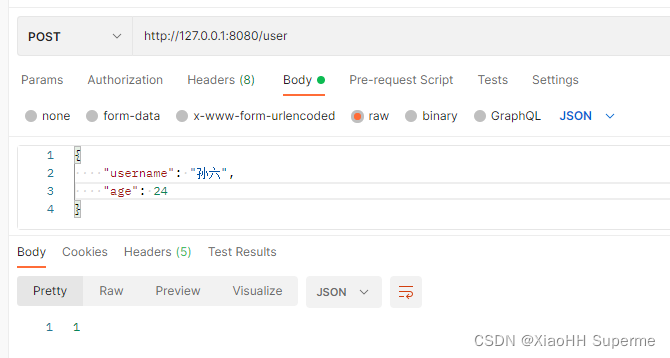
查詢一下:
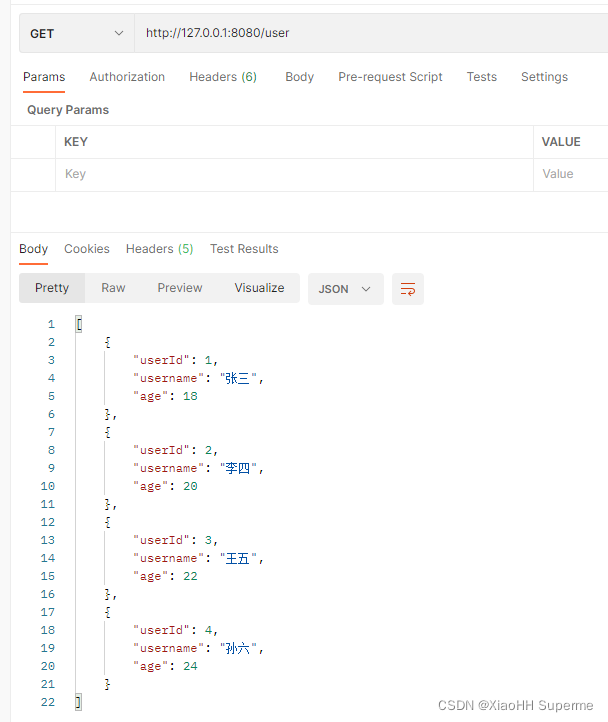
同時訂單數據庫: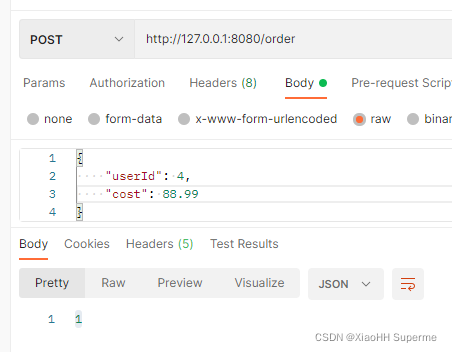
查詢:
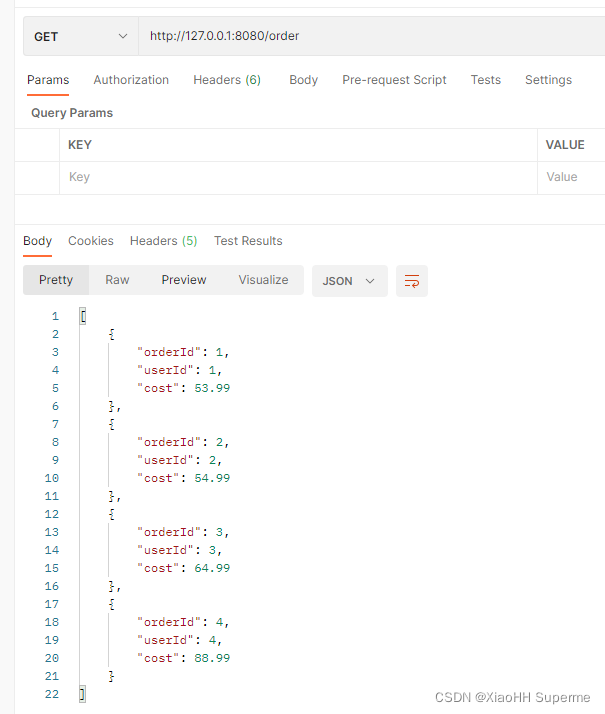
然后在數據庫當中查看是否是發送到不同的數據庫:
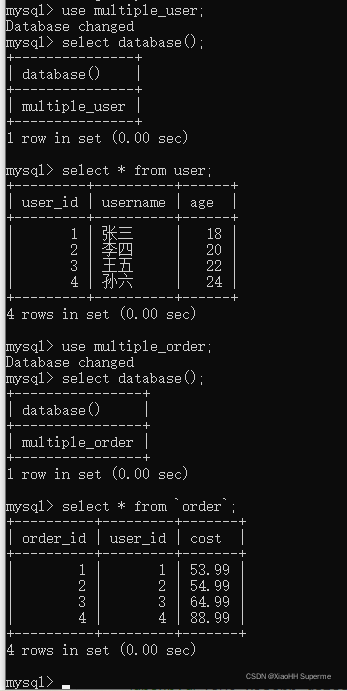
可以確定,確實是存入了兩個數據庫。
以上是“SpringBoot如何搭建多數據源”這篇文章的所有內容,感謝各位的閱讀!相信大家都有了一定的了解,希望分享的內容對大家有所幫助,如果還想學習更多知識,歡迎關注億速云行業資訊頻道!
免責聲明:本站發布的內容(圖片、視頻和文字)以原創、轉載和分享為主,文章觀點不代表本網站立場,如果涉及侵權請聯系站長郵箱:is@yisu.com進行舉報,并提供相關證據,一經查實,將立刻刪除涉嫌侵權內容。